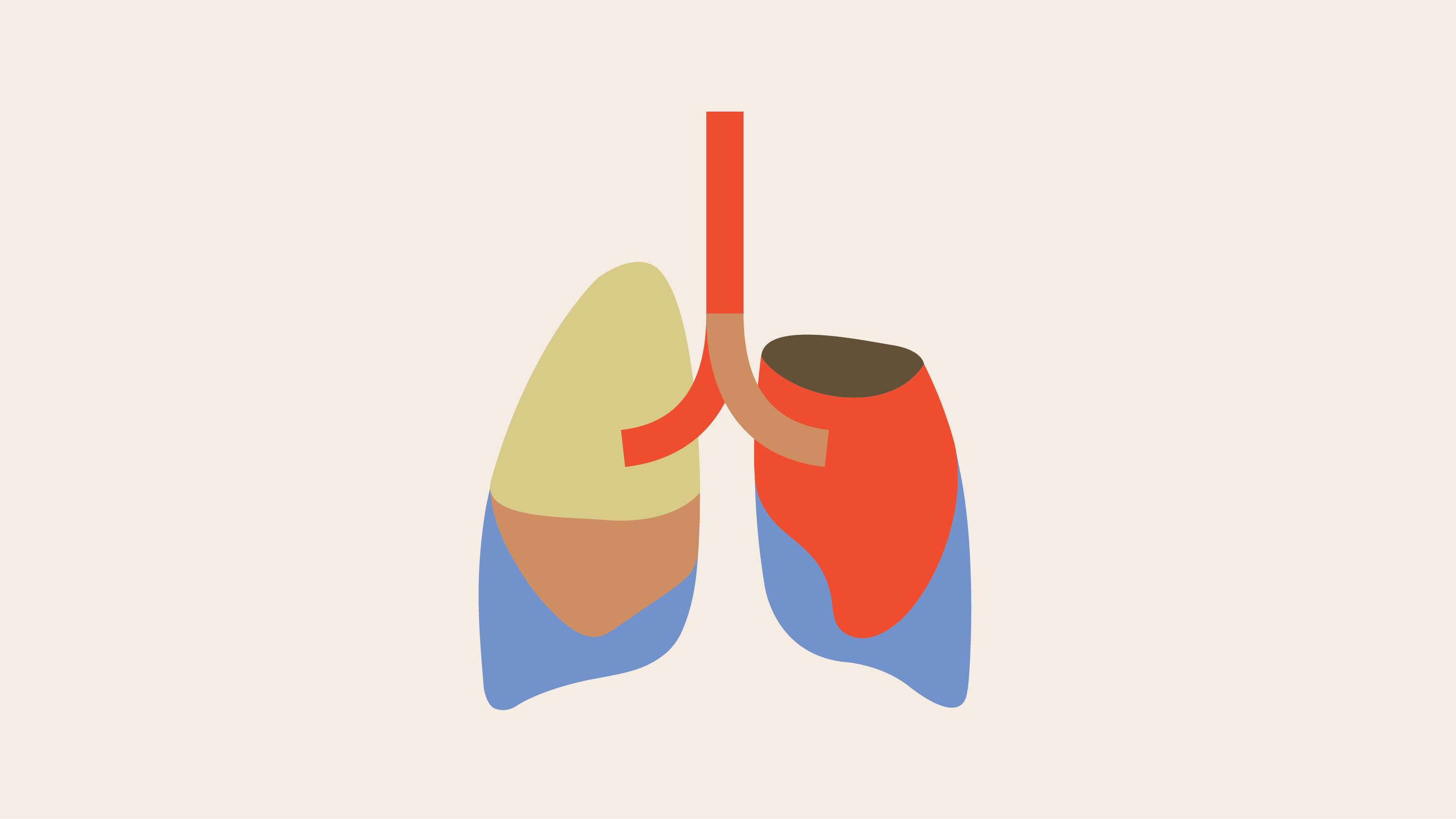Living with Lung Cancer
Resources, expertise, and survivor support to help in the months & years after diagnosis
To help you along the way during your fight against Lung Cancer, SurvivorNet has developed a series called Living With Lung Cancer. This series is designed to help you navigate some of the challenges that may pop up during treatment and beyond.

General Information
General information to help along the way
We know that you’ve likely already made many tough decisions and are preparing to begin the next step in your journey, which may be treatment or simply adjusting to a new normal.
While you let the medical information set in, you may find yourself second-guessing decisions. This is common and experienced by many people going through this process. Here, we cover some often-overlooked topics, including connecting with others, information about your job, and the financial cost of treatment.
There are a few basic things you can do to help manage the process when you first learn of your cancer diagnosis.
- Have someone come with you to the doctor
- Take notes
- Don’t be afraid to get a second opinion
+ Expand and Learn More...
“What would you do if someone in your family got cancer?” We put that question to some of the most renowned cancer doctors in the country. National Cancer Institute Chief of Surgery Dr. Steven Rosenberg recommends seeking out multiple professional opinions to confirm a diagnosis and figure out the options.
Patients should not feel guilty about doing this — as many doctors will recommend and even encourage it.
As we highlight in several areas of SurvivorNet, highly respected doctors sometimes disagree on the right course of treatment, and advances in genetics and immunotherapy are creating new options.
Also, in some instances the specific course of treatment is not clear cut. That’s even more reason why understanding the potential approaches to your disease is crucial.
While life is filled with uncertainties, people living with cancer may feel this at a more extreme level.
Dr. William Breitbart, the chair of the Department of Psychology and Behavioral Sciences at Memorial Sloan Kettering Cancer Center, explained that learning to embrace that uncertainty is a part of living not just for those fighting cancer, but for everyone.
+ Expand and Learn More...
“What the task becomes is having the courage to live in the face of uncertainty, realizing that you cannot necessarily control the uncertainty in life … the suffering that occurs, challenges both good and bad,” Dr. Breitbart said.
“You may not be able to control those but you have control over how you choose to respond.”
Those struggling with feelings of loss of control that cancer can bring can seek help in many different ways — from traditional therapy to support groups for people living with cancer to making lifestyle adjustments to help cope with stress.
Lung Cancer Staging
How is Lung Cancer Staged?
In the early days of treatment planning for lung cancer, you may feel completely overwhelmed by information. At this point, you’ve likely had a phone call or met with your doctor and were told you have lung cancer.
An appointment was most likely scheduled for you to meet with a larger team to find out the details about what’s next. The path forward depends on several aspects of your individual disease.
Understanding how lung cancer is staged gives practitioners and patients valuable information about their disease. Staging allows medical professionals to describe cancer based on its location, size, and whether it has spread.
First, the lung cancer type must be determined. Then, cancer can be staged to understand the cancer’s individual characteristics better. This information is useful when determining what treatment types are most appropriate.
+ Expand and Learn More...
Staging can also be used to predict how cancer may progress and respond to various therapies.
“The stage is really the essence of how you determine what the correct treatment options are,” said Dr. Joseph Friedberg, chief of thoracic surgery at Temple University Health System.
Stage 1 and 2 lung cancer is considered “early-stage” disease, while stages 3 and 4 indicate that cancer has spread further into the body — and the treatment approaches will vary.
+ Expand and Learn More...
The lung cancer staging process begins once a lung cancer diagnosis is confirmed. Beyond an initial computed tomography (CT or CAT) scan, your doctor will likely order a brain magnetic resonance imaging (MRI) scan to see if there is any evidence of disease in the brain, a common area of metastasis, and a positron emission tomography (PET) scan to see whether the lung cancer has metastasized to your bones, adrenal glands, and/or liver.
TNM Classification of Tumors
The American Joint Committee on Cancer (AJCC) TNM classification system is the lung cancer staging system utilized in NSCLC. The stage of cancer is dependent on a combination of these three factors listed below.
- Tumor (T) refers to the size/shape and extent of the primary tumor’s growth, as well as its specific location. This category can be assigned a letter or number, which correlates directly to the primary tumor’s size/size and location.
- Nodes (N) refers to the involvement of lymph nodes. This category helps to determine whether the cancer has advanced to the lymphatic system.
- Metastasis (M) refers to the spread of cancer to any other organ(s).
If you want to learn more about lung cancer staging, make sure to check out SurvivorNet’s break-down of the process.
Types of Lung Cancer
Understanding your type of lung cancer
Lung cancer, like all cancers, comes in many different forms.
One key distinction is whether your cancer is non-small cell lung cancer (NSCLC) or small cell lung cancer (SCLC). The large majority of lung cancers — about 85% — are NSCLC, while only about 15% are SCLC.
+ Expand and Learn More...
Non-small cell lung cancer
There are three general subtypes of NSCLC: squamous cell carcinoma, adenocarcinoma, and large cell carcinoma.
Adenocarcinoma, which accounts for about 40% of all NSCLC cases, is the single most common subtype of lung cancer. It is typically found along the outer perimeter of the lungs and tends to progress at a slower rate compared to other lung cancer types.
Squamous cell carcinoma typically manifests in the central portion of the lungs. Due to this central localization, symptoms are often exhibited earlier rather than later compared to other types of NSCLC.
Large cell carcinoma is the rarest main classification and accounts for about only 15% of cases.
Other less common subtypes of NSCLC include the following: carcinoid tumor, salivary gland carcinoma, pleomorphic, and carcinomas that remain unclassified.
Small cell lung cancer
SCLC makes up approximately 15% of lung cancer occurrences. Smoking tobacco is the chief risk factor for this specific kind of lung cancer.
SCLC is split into two subcategories, which include small cell carcinoma (also termed ‘oat cell cancer’), and combined small cell carcinoma, which is a mix of both small and non-small cell lung cancer. This type of lung cancer is typically characterized as evolving and metastasizing relatively quickly and aggressively.
Assembling Your Team
Assembling your treatment team
The process of finding the right doctor and deciding where to get treatment can be stressful in itself.
When faced with something as life-changing as a cancer diagnosis, it can be easy to overlook some options. For lung cancer, multidisciplinary centers are a great option because they offer patients the opportunity to work with multiple specialists all in one place.
Regardless of where you begin your treatment process, there may be several specialists involved in your care — your treatment team, if you will.
It’s often a pulmonologist or lung specialist who makes the initial lung cancer diagnosis by evaluating symptoms, such as coughing and shortness of breath, and analyzing a subsequent lung biopsy.
The next step is typically a meeting with a medical oncologist and/or several other specialists — including a thoracic surgeon and a radiation oncologist — to determine the stage and extent of the cancer.
This important process may include scans of the chest, abdomen, pelvis and brain to see if the cancer has started to spread outside of the lung. In addition, pulmonary function testing may be performed to get a baseline of your lung reserve and suitability for surgery. The results will guide treatment decisions.
+ Expand and Learn More...
Not everybody can get to a designated comprehensive cancer center, but the data is clear that these centers are extremely helpful, especially when your disease is complex.
There are plenty of excellent physicians who are not at comprehensive cancer centers. That being said, when you are looking into care, you should be asking, “Am I getting doctors with different specialties like medical oncology, radiation oncology, surgery, pathology and radiology?”
The really important thing is that you’ve got the right people and that they know the latest science.
That can happen away from a major cancer center, or it can happen at one. In order to get the best guidance, you will need to sift through the options in your area — and consider if you need to travel to a larger medical center.
Treatment Options
Understanding your treatment options
Treatment for lung cancer depends on the stage, among other factors. If you have early-stage disease (stage 1 or 2), and are deemed a candidate for surgery, the best option is to attempt to remove the cancer this way. You may undergo pulmonary function testing in order to determine if surgery can be safely performed.
If surgery is not an option, a type of radiation treatment called stereotactic body radiotherapy (SBRT) may be used.
+ Expand and Learn More on Stage 1 ...
Stage one lung cancer means that your cancer is only in your lungs and has not started to spread to your lymph nodes or beyond your lungs to other organs throughout your body.
When you are diagnosed with lung cancer your medical team will conduct a series of tests to determine what stage the cancer is and how to best treat your lung cancer. The process of conducting additional tests and imaging studies is called lung cancer staging and is the backbone of what informs treatment decisions.
For individuals with stage 1 cancer who can’t have surgery because of underlying health conditions, the current standard of care is stereotactic body radiation therapy (SBRT), which directs extremely high doses of radiation to the tumor and minimizes the dose to nearby structures, reducing the risk of damage to healthy organs.
This type of treatment is becoming much more common and is being used more frequently even in patients who are healthy enough for surgery but who choose to have SBRT as a non-invasive option after an informed discussion with their treating teams.
Although surgery remains the current gold standard for treating stage 1 lung cancer, there are currently trials comparing these two approaches (surgery and SBRT) head-to-head to determine which is best for patients.
For now, surgery remains the best option, but if you or a loved one is not able to have surgery, SBRT is an excellent alternative with tumor control rates approaching those seen with surgical resection in some studies.
+ Expand and Learn More on Stage 2 ...
Stage 2 lung cancer is considered a localized disease and is primarily treated with surgery.
Dr. Geoffrey Oxnard tells Survivornet: “Surgery to remove a lobe of the lung (a lobectomy) and the affected lymph node(s) is the first-line treatment for stage 2 lung cancer. ”
In some patients who achieve a negative margin resection (no tumor left after surgery) and who have no lymph nodes involved with cancer, surgery is curative and no additional therapy or treatment is needed. This group of patients will be monitored for cancer recurrence by their oncologists but do not require additional treatment with chemotherapy, targeted agents, or immunotherapy.
When are additional treatments needed?
In some cases, chemotherapy may be recommended after surgery to lower the risk of cancer coming back or spreading. Chemotherapy given in this manner is called adjuvant and when treating lung cancer is typically a platinum agent like cisplatin.
Chemotherapy is often recommended in patients with high-risk features such as tumors greater than 4 cm, poorly differentiated, tumors that invade the visceral pleura tumors, or have vascular invasion. There are other factors your clinical team will also consider when deciding on whether chemotherapy is right for you.
In addition to chemotherapy, some patients may also be considered for other therapies — including the targeted agent osimertinib and the immunotherapy drug called atezolizumab.
Patients that underwent surgery but have residual disease left behind may also be candidate for not only chemotherapy but also radiation.
These drugs are very different from chemotherapy and are often much better tolerated. However, to receive these drugs the tumor must test positive for certain biomarkers that allow these drugs to be effective.
+ Expand and Learn More on Stage 3 ...
The treatment for stage 3 lung cancer depends on if you have stage 3A or a more advanced stage 3 cancer like stage 3B or stage 3C.
The decision to proceed with surgery for stage 3A lung cancer is not always black and white, and it’s an area where doctors can disagree. In stage 3A, where the cancer has spread to the lymph nodes on the same side of the chest where the cancer started, surgery can play a role depending on where the cancer is, how close it is to other structures, and how many lymph nodes are affected.
Chemotherapy or radiation may also be an option before surgery to shrink the tumor and destroy any errant cancer cells.
In other scenarios, some people with stage 3A cancer will be treated with radiation therapy and chemotherapy followed by immunotherapy without surgery.
If the cancer is EGFR+ targeted therapies may be added post-surgery as well. Immunotherapy drug pembrolizumab (Keytruda) may be used alone as your first treatment when your lung cancer has not spread outside your chest (stage 3) and you cannot have surgery or chemotherapy with radiation.
With stage 3B lung cancer or stage 3C, your cancer has spread to the lymph nodes on the opposite side of your chest or has invaded another area such as the veins feeding your heart.
For patients with stage 3B and 3C lung cancer, radiation therapy with chemotherapy followed by immunotherapy is the standard of care.
Most patients with stage 3 lung cancer will have radiation therapy with chemotherapy followed by immunotherapy to treat their disease. Surgery is only used for very select patients with stage 3A disease.
+ Expand and Learn More on Stage 4 ...
In stage 4 lung cancer, the disease has spread to other regions of the body, which is called metastasis.
Stage 4 is the most advanced cancer stage. Lung cancer is commonly already in stage 4 when it is first diagnosed because it often does not present symptoms until it has spread.
The National Cancer Institute estimates that about 55% of lung or bronchus cancers are first diagnosed at this stage.
Late-stage disease that has metastasized and is widespread throughout the body is often considered incurable.
In this case, the goal of treatment is to control/shrink the tumor, reduce symptoms, continue a positive quality of life, and try to prevent further metastasis and subsequent complications.
+ Expand and Learn More...
Undoubtedly, stage 4 lung cancer treatment can be difficult. This is because, by the time you have developed metastasis, your tumor will have spread beyond the lung to other parts of the body through your blood or lymph nodes and can be difficult to control.
But it’s important to know that there are still many treatment options available and treatments are improving every year. These include surgery, chemotherapy, and radiation, as well as the newer targeted drugs and immunotherapy agents.
As Dr. Raja Flores, chair of the Department of Thoracic Surgery at Mount Sinai Hospital, explains: “you have to realize stage 4, again, does not mean death. You can have stage 4 [patients] who are alive 8, 9, and 10 years later. There are people out there who are walking around who have had brain metastases, but it’s kept quiet.”
Genetic Testing
Genetic testing & lung cancer treatment
Genetic testing of lung cancer helps to guide treatment decisions. Specifically, there are targeted therapy options available if a patient has certain genetic biomarkers, sometimes called “driver mutations.”
Cancer cells that have genetic mutations continue to multiply, and each copy contains the same genetic mutation. Targeted therapies work using these specific mutations. Performing genetic testing prior to treatment is critical. Common mutations that have approved drugs include:
- EGFR gene mutation
- KRAS gene mutation
- ALK rearrangement
- ROS1 rearrangement
- NTRK gene fusion
- BRAF V600E Mutation
- ERBB2 mutation
- RET rearrangement
- METex14 mutation
+ Expand to Learn More About Targeted Treatments...
Cancerous cells can be tested for these genetic mutations using two techniques. The first is a biopsy in which a physical sample of the tumor is removed and tested.
The second method is through a liquid biopsy or blood test. Liquid biopsies are currently only used when tissue can’t be obtained from traditional biopsies.
It is critical that these genetic mutations and biomarkers are evaluated because the use of targeted therapies is possible; these medications have proven to be more effective than traditional chemotherapy and often have fewer or more tolerable side effects. They also have better side effects profiles because the tumor is specifically targeted, and healthy tissue is not damaged.
Next-generation sequencing (NGS), frequently referred to as molecular testing or profiling, is a testing method that looks for mutations in your tumor. Mutations are errors in your genes that can create tumor growth and spread. NGS testing allows your doctor to look for many mutations or alterations at once. Identifying these changes can help your doctor figure out the best treatment plan for your lung cancer.
+ Expand and Learn More...
“It’s absolutely clear that every stage four patient with non-squamous, non-small cell lung cancer should have comprehensive and sensitive molecular testing done early, and with PD-L1,” Dr. Jared Weiss, a medical oncologist specializing in lung and head and neck cancer at UNC Lineberger Comprehensive Cancer Center, tells SurvivorNet.
PD-L1 refers to an expression of a protein on cancer’s surface that it may be using to avoid detection by the immune system.
NGS has become the standard of care in lung cancer treatment. You may be a candidate for NGS testing if you have been diagnosed with:
- Advanced stage adenocarcinoma of the lung
- Advanced stage squamous cell cancer of the lung
- Advanced stage adenosquamous cancer of the lung
In early stage lung cancer, you should discuss if NGS testing could be right for you, too.
+ PD-L1 testing - Expand and Learn More...
PD-L1 testing
PD-L1 testing is different from NGS Testing. It measures the level of certain proteins in cancer cells.
“It’s standard of care to get some kind of PD-L1 testing,” says Dr Weiss. “It’s really fast, it’s really cheap, it’s really easy. You can do it anywhere in the country.”
PD-L1, also know as programmed cell death 1, is a protein that is found on the outer surface of cells in your immune system. Dr Weiss also explains: “PD-L1 is not a mutation. It is an expression of a protein on the cancer surface, that it might be using to hide from the immune system”
If you were recently diagnosed with lung cancer, your oncologist should discuss PD-L1 testing with you. This laboratory test helps physicians determine whether a patient will likely benefit from immunotherapy, since a third of patients with late-stage NSCLC have high levels of PD-L1.
+ EGFR-mutation - Expand and Learn More...
EGFR-mutation
- The rate of EGFR-mutated lung cancer can vary depending on the population, but it typically comprises around 15% of North American and European patients. It can be almost 50% in Asian populations.
- Patients with lung cancers with EGFR mutations tend to have minimal to no smoking history.
- EGFR is like a switch on the cell that when activated tells the cell to grow. When EGFR mutates it is constantly turned on, which means the cell grows too much. This can result in cancer growth. If your lung cancer has a mutation in EGFR, it is called an EGFR-mutated lung cancer or EGFR-positive lung cancer, which is a specific subtype. This can affect treatment options and also tells us how the cancer typically behaves.
Targeted and Immunotherapy
What is targeted therapy?
Targeted therapy, or matching treatments to diseases based on very specific characteristics such as genetic mutations, has changed the way lung cancer is treated — and has made the doctor-patient conversations about treatment slightly more complex.
In the past, chemotherapy — which attempts to kill all fast-growing cells in the body — was considered the treatment standard for stage 4 lung cancer, but treatment methodologies are changing.
These advances involve testing your cancer for the presence of genetic mutations, or molecular features, which might be targets for relatively new medications. For some people, these medications are extending life in remarkable ways.
+ Expand and Learn More...
Many researchers believe that precision medicine, or targeted therapies, are the way forward.
Getting genetic and molecular testing is, as we said, the key first step to determining if you are eligible for a targeted therapy
Your doctor will need to figure out if you have a genetic mutation such as KRAS, ALK, or EGFR. If so, your doctor can look into whether your cancer might be treated with the growing number of medicines that more precisely target a specific mutation. Other examples of targeted therapies include MET, RET and ROS1 inhibitors.
If your cancer is over-expressing epidermal growth factor receptor (EGFR), a protein that makes cells grow and divide, drugs blocking EGFR may be used.
Targeted therapy seeks out very specific cancer cells and leaves the healthy cells alone. Chemotherapy tends to cause a lot of collateral damage because it kills all fast-growing cells — both healthy and cancerous.
+ Expand and Learn More...
Dr. Geoffrey Oxnard, a thoracic oncologist at Boston Medical Center, stressed the importance of testing tumors so that patients can have options.
“If you haven’t had testing of your tumor, you need to get your tumor figured out,” he explained.
“In doing so, that creates targeted therapy options. When I say targeted therapies, I mean patients of mine who are taking a pill once a day. Their cancers melted away. I see them every few months. They’re living fully.
“Some days, they forget they even have stage 4 lung cancer … This is what I want for my patients.
“It’s not possible for everyone, but testing is appropriate because through testing, you get options.”
Immunotherapy is a type of biological therapy that ushers the power of a person’s immune system to recognize and conquer cancer cells.
This includes recruiting internal mechanisms like the body’s proteins, white blood cells, tissues, and organs or through external mechanisms by synthesizing molecules in the lab.
Each type of immunotherapy works differently depending on many factors. While some will work to kill or destroy cancer cells, others will only stop them from growing and spreading to other organs.
+ Immunotherapy for Earlier Stage Lung Cancer - Expand and learn more
Immunotherapy for Earlier Stage Lung Cancer
- For people with earlier stage lung cancer that can potentially be taken out with surgery, the FDA has approved the immunotherapy drug nivolumab (brand name Opdivo) for use with chemotherapy prior to surgery.
- This is a new sequencing of treatment for lung cancer patients for whom surgery is an option.
- Opdivo helps the body reignite it’s defense against cancer by actually blocking a part of the immune system which is preventing the body from fighting cancer. This is called check-point inhibition and it works much more effectively when a protein called PDL-1 is present in higher amounts.
- Opdivo + chemo, given before surgery, is proven in a clinical trial to reduce the risk of cancer spreading or returning by 37% compared to chemo alone.
- According to experts, it is important to ask your doctor whether this new treatment sequencing could be right for you and whether testing of your tumor from a biopsy reveals anything about the characteristics of the cancer which might help the decision making process for the use of immunotherapy.
+ Targeted therapy (Tagrisso) for Stage IV EGFR-positive lung cancer - Expand and Learn More...
Targeted therapy (Tagrisso) for Stage IV EGFR-positive lung cancer
- For lung cancer patients with an EGFR mutation, “TAGRISSO is the best drug in the metastatic setting,” Dr. Roy Herbst, told SurvivorNet. Dr. Herbst is a nationally recognized lung cancer researcher who serves as deputy director and chief of medical oncology at Yale Cancer Center and Smilow Cancer Hospital.
- The use of Tagrisso plus chemotherapy improved progression-free survival (PFS) by 9 months as compared to Tagrisso alone in patients with locally advanced or metastatic EGFR-mutated lung cancer. PFS means how long a patient goes after a treatment without the disease progressing or death.
- At this time the current standard of care for metastatic EGFR-mutated lung cancer is typically taking Tagrisso alone.
- If you have EGFR-mutated lung cancer and have questions regarding Tagrisso and combination chemotherapy, please don’t hesitate to talk about it with your healthcare team.
+ Targeted therapy (Tagrisso) for Early Stage EGFR-positive lung cancer - Expand and Learn More...
Targeted therapy (Tagrisso) for Early Stage EGFR-positive lung cancer
- Adults treated with one Tagrisso 80-mg pill once a day after surgery were 80% less likely to have their cancer come back or die compared to placebo (no active medicine).
Side Effects
Managing the side effects
Cancer treatment affects everyone differently. Some will experience little to no side effects while others may need additional medical intervention to curb side effects.
It’s critically important to keep your medical team in the loop about any side effects you begin to feel right away so adjustments can be made if they’re needed.
+ Expand and Learn More...
Radiation therapy itself is painless, but some people may experience some general side effects as soon as seven to 10 days after treatment starts.
According to the American Cancer Society, these may include:
- Fatigue
- Nausea and vomiting
- Appetite loss
- Blistering or peeling skin
- Hair loss in the treatment area
These side effects can be severe if the radiation is given along with chemotherapy, but they usually go away after the treatment ends.
If the radiation is directed to the middle of the chest, your food tract, or esophagus, may become inflamed, making it difficult to swallow.
Some people may also have heartburn and trouble eating solid foods for a while.
Melissa Culligan, a thoracic surgery nurse at the University of Maryland Medical Center, says it’s important that you stay in close touch with the members of your cancer care team and notify them of any discomfort so that they can help manage these issues.
+ Expand and Learn More...
“It’s critical after surgery that you do keep active and keep your body in the best possible condition,” says thoracic surgery nurse Melissa Culligan.
She stresses how important it is to keep in close contact with the members of your care team to let them know about the severity of your pain and discomfort, as well as any anxiety and stress that you may feel.
+ Expand and Learn More...
For patients undergoing lung cancer treatment, diarrhea is one of the most common side effects of chemotherapy or immunotherapy treatments. If it’s severe, it can affect your continued treatment.
It’s important to be very detailed in the description of your condition when you contact your care team, says thoracic surgery nurse Melissa Culligan.
So what can you do to manage it?
Doctors often recommend drinking more water, clear broth or decaffeinated fluids to replace the fluids and electrolytes you lose — and to avoid certain foods that trigger or worsen diarrhea like milk, spicy, or fatty foods. Other suggested recommendations include eating low-fiber foods, trying probiotics, and eating five to six small meals a day.
Living With Cancer
Living with cancer
Living with cancer can certainly manifest a mix of emotions and obstacles.
Perhaps one of the biggest obstacles you’ll have to deal with is cancer treatment and learning to cope with a new normal, as well as potential side effects. While everyone has their own journey with cancer treatment, experts have some golden rules to follow that are effective in getting through it.
Based on years of experience, Dr. Geoffrey Oxnard, a thoracic oncologist at Boston Medical Center, says he has a simple set of rules he tells his patients to help them cope.
- Don’t act sick
Just because you have cancer doesn’t mean that you have to stop doing the things that you enjoy. Stay active.
- Don’t lose weight
Cancer can eat away at your physical reserves, so it’s important that you top them up with the calories and nutrients you need to fight the disease.
- Don’t be a tough guy
When you have cancer, things like diarrhea or tingling nerves can be a sign that the dose or frequency of your treatment needs to be adjusted. Speak up and let the members of your care team know so that they can help.
Ultimately, dealing with your cancer treatment means staying positive, having full communication with those who can help and support you, and remembering that your life went on before treatment, and can go on just the same after treatment. There’s no reason why it shouldn’t go on during treatment.
And yes, you have the strength!
+ Expand and Learn More...
Dr. Ken Miller, Director of Outpatient Oncology at the University of Maryland, Greenebaum Cancer Center, has an additional four tips to help keep cancer survivors healthy. They include:
1. Exercise at least two hours a week — and walking counts.
2. Eat a low-fat diet.
3. Eat a colorful diet with lots of fruits and vegetables. The American Cancer Society recommends aiming for two to three cups of vibrant vegetables and fruits each day.
4. Maintain a healthy weight. Studies have shown that being obese can increase your risk for several types of cancer.
Survivor Stories
Inspiring survivor stories
After — or during — the cancer treatment process, it can be really helpful to hear the stories of people who have been through the same struggles and how they coped and learned to live with, and move on from, the disease.
In this section of our Living with Lung Cancer guide, we’re sharing the stories of incredible (and inspiring) lung cancer survivors.
Integrative medicine
Meditation? Medical marijuana? Integrative medicine can help you cope
Integrative medicine can be really helpful both during and after cancer treatment, but it’s important to understand the difference between integrative medicine and alternative medicine.
These days, many cancer doctors support integrating other methods into care, as long as patients understand that “integrative” — or holistic — medicine and “alternative medicine” — which seeks to replace approved treatments and often has little or no science to support it — are two different things.
Integrative medicine blends things — like diet and stress management — with conventional medicine.
Your doctor may also suggest things like acupuncture, yoga and meditation, or even medical marijuana to ease pain and other side effects.
+ Expand and Learn More...
A lot of people dealing with pain and other side effects of cancer have already tried more traditional methods before they decide to give medical marijuana a try, according to integrative cannabis physician Dr. Junella Chin.
“When you take plant-based cannabis, marijuana, you’re decreasing inflammation, and you’re relieving pain at the same time,” Dr. Chin explained.
But how can pot do this, and why? Dr. Chin explains that humans have a natural cannabis system, or an endocannabinoid system, that our bodies create. When a person is in chronic pain though, these natural pain relievers aren’t enough.
“So when we utilize phytocannabinoids from the cannabis plant, we are actually replenishing our body’s own cannabinoid system. By doing so, it helps us deal with pain and inflammation much more effectively,” she said.
Many cancer survivors have found solace in meditation during or after the treatment process.
When dealing with a journey that can be nerve-wracking and very emotional, it can really help to take some time to quiet the mind.
More Resources
Living with Lung Cancer
We have made it to the end of the Living with Lung Cancer series. We hope that you were able to find some helpful information and some of the support you are looking for as you embark on your journey as a cancer survivor.
Be sure to check out SurvivorNet’s designated Lung Cancer section for a breakdown of the basics of the disease, treatment options, and what you can expect as a survivor.
We also provide regular updates on any new treatment options and inspiring stories from survivors like you.
At SurvivorNet, we’re here to help survivors navigate the complex world of living with cancer. Thank you for being part of the family!

Please confirm you are a US based health care provider:
Yes, I am a health care Provider No, I am not a health care providerSign Up Now.
Take Control of Your Disease Journey.
Sign up now for expert patient guides, personalized treatment options, and cutting-edge insights that can help you push for the best care plan.






























